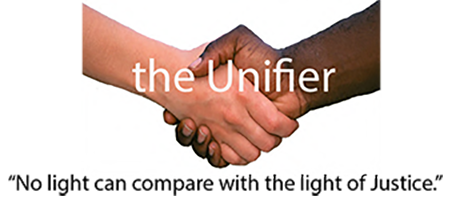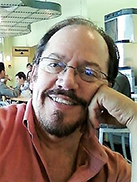I’ve been a believer in one human family since I was a young boy, but it was only recently that I came to realize the impact of the concept.
My father was my original example. He was sixteen years old when the Japanese attacked the U.S. Navel base at Pearl Harbor and drew the country into World War II.

Like many young men of the day, dad lied about his age and got accepted into the U.S. Navy and after a brief boot camp found himself on the USS Essex aircraft carrier in the Pacific where he was wounded, losing all his fingers on his left hand. He had every reason, most people would say, to hate the Japanese.
In 1950, just five years after the end of the war with Japan many Americans still harbored a deep-seated hatred for the Japanese. There were several reasons for these feelings. Part of it was that the Japanese military mistreated, even tortured, their prisoners to a much greater degree than the German Nazi military. Another reason was that their surprise attack on Pearl Harbor in which more than 2,000 Americans perished was technically during peace time. There was no state of war existing between America and Japan when they launched their attack and that felt unfair and undeserved to the American public. But there was another reason for this hatred and it was racism. Even though both the Germans and the Japanese were our enemies the Germans looked like us while the Japanese didn’t. They were different and they were considered inferior.
Even though this hatred still existed in 1950 my father became close friends, you could even say best friends, with a Japanese man named Goonshee who had come to our hometown of Corpus Christi, Texas, to work at the newspaper where my father worked as a photographer. It would have been easy for him to hate the Japanese and by extension, Goonshee, but he didn’t.
1950 also saw him making friends with Melvin Helms, a Black American who was a window dresser for Lichtenstein’s a large department store here in town.

For those who don’t know the term, a window dresser is someone who designs and installs an attractive display of clothes and other sales items in a store window. Retail stores of this era between the 1920’s and the early 1960’s had massive windows in which replicas of life were set up. A living room, bedroom or kitchen complete with mannequins were posed like real people, or a family at the beach with bathing suits and towels, and beach balls, etc. Melvin was the head dresser and well respected, that is well respected for a Black man living in the South during the Jim Crow era.
Melvin lived in the Hillcrest neighborhood, known as “the Cut” or the “little Harlem” of Corpus Christi where all the Blacks lived isolated and separated from the “good” White people of Corpus Christi, who were for the most part either frightened of them or felt superior to them, and usually a little of both.
Jim Crow Texas was still in full swing and Blacks had few rights. I remember the “separate but equal” excuse for segregation, the separate restrooms, water fountains with signs that read “Whites Only”, and restaurants that only served Whites.

I also remember me and my sister falling asleep on Melvin’s couch along with his kids while my parents played cards with Melvin and his wife, Jean. I remember waking up in bed with his kids. This all felt normal to me, just like doing these things with my parent’s White friends, Japanese friends, Hispanic friends, Jewish friends, etc.
In 1965 while the civil rights movement was in full swing throughout the country my dad and Melvin attempted to integrate Price’s Chef a local diner and had the police called for the attempt.

My dad and I didn’t have the best relationship so it took me many years to acknowledge the racial equality example that he had set for me. I understood the lesson, just not him as the source.
When I was nineteen I encountered the Bahá’í Faith while living in Houston. It’s founder taught the principle of one human family and Bahá’ís called it “One Mankind.” The Bahá’í slogan of the day was “One God, One Religion and One Mankind.” It was, and is, a Faith that lives up to its commitment to one human family. Obviously, every person has their own personal ‘baggage’ that they carry around and bring to any and all groups that they join or associate with, including the two very private groups of Faith and Family. Bahá’í acknowledges such baggage, but is a place that expects, and one could say demands, that every individual continuously work to rid themselves of the destructive baggage they carry.
Though I’ve had my father’s example for these many years and been a part of a Faith that expects me to work on my issues, it is of late, like many Americans, that I have come to believe that I must do more to bring about an end to racism. Obviously, the death of George Floyd, was a turning point for millions of Americans, including myself. As the Black Lives Matter organization clearly states, “Enough is Enough.”
As I have pondered this entire situation, I have come to a fresh conclusion and that is that One Human Family is fundamental to nearly all of the world’s problems – Racism, Gender Inequality, Extreme Nationalism, Fundamentalist Religion and much more. It is really very simple. If you believe there is only one race, the human race and that every human on earth is therefore equal to every other human its difficult to impossible to mistreat others. There are, in fact, no ‘others’ to mistreat, there is only ‘us.’
However, if you believe humanity is divided into sub-categories – African humans and Asian humans and European humans, then you believe in differences – differences which are easy to ‘exclude’ instead of ‘include’. Once you have clubs and organizations that only cater to one type of human, it becomes easier to think in terms of those other humans having some deficiency, some fault.

As we saw in the World War II Nazi regime it is a slippery slope that can quickly take you from just believing that some subgroup lacks your refinement to that subgroup being ‘not human’ and therefore not subject to the ethical rules of not harming another human being taught by all original religions.
You are now free to take your neighbor’s possessions, to beat him, run him out of town or even kill him. Meanwhile, he no longer has the protection of the police to stop you. You can defile his graveyards and his holy places. You can also wage war against your neighboring countries and not have to worry about committing war crimes such as genocide.
I have devoted an entire category to the subject of gender inequality. Even if there is some actual reason to discriminate against the neighbor next door, the nation next door, etc., how can men consider women as “other.” If there is one discrimination greater than any other, and I don’t really think that we can rank them, then gender discrimination may be it. Men and women love their sons and their daughters, but socialize them differently, and with biasness. It is unfathomable to me.
In 1992 author Dr. John Gray published his now famous book, “Men are from Mars, Women are from Venus: The Classic Guide to Understanding the Opposite Sex.” His point was to say that although men and women are different in many ways we can get along if we respect those differences. Unfortunately, many people stress the literalness of the title to believe that women and men are different and therefore can’t get along.
Accepting the root principle of one human family also addresses the inequality of genders. The Bahá’í Faith has an analogy that it employs to illustrate the necessity of gender equality, and that is the example of the bird.
“The world of humanity has two wings — one is women and the other men. Not until both wings are equally developed can the bird fly.”

This is an apt analogy owing to the fact that each wing isn’t a replica of the other but is a mirror image of the other, just like our left hand is a mirror image of our right hand. Each wing is different, however, both must be equally developed, equally strong. If they are the bird can fly if they aren’t, if one wing is atrophied the bird will never get off the ground. That is humanity will never fully develop to its capacity. That is it will never have peace, never have unity, never have justice, never have joy, it will however always have strife, always have contention, and always have injustice.
Such a little sounding concept, one human family, yet so much wrapped up in it.
I’d like to leave you with a couple of thoughts that we will explore more in-depth at a later time. The first is the idea that a person can’t achieve what they can’t imagine. You might be familiar with an old saying that says, “I’ll believe it when I see it.” Actually, I want you to turn that saying on its head and realize that you can’t see it until you believe it. More to follow!
The second thought is this. Imagining, or believing in, the spiritual concept of ‘one human family’ sets a benchmark, as carpenters might say, or a milestone as a traveler would say. If you are to travel a long distance from point A to point B, Racial Disunity to Racial Unity you can’t measure that journey in one long piece, you have to break it up into segments. Traveling from my hometown of Corpus Christi to Houston is approximately a three and a half hour trip. But I mentally divide it into segments. I might look forward to reaching Victoria for a rest break and something to drink. From there I look ahead to Wharton, and then Sugar Land and finally Houston. A milestone gives me a measure to judge how I’m doing and something to strive towards. We’ll look at these two concepts again, however, for the movement let’s think of moving from distinct races to race amity (friendship) and finally to race unity.


